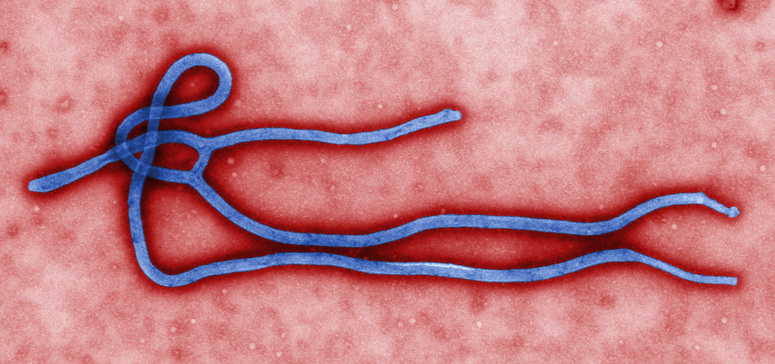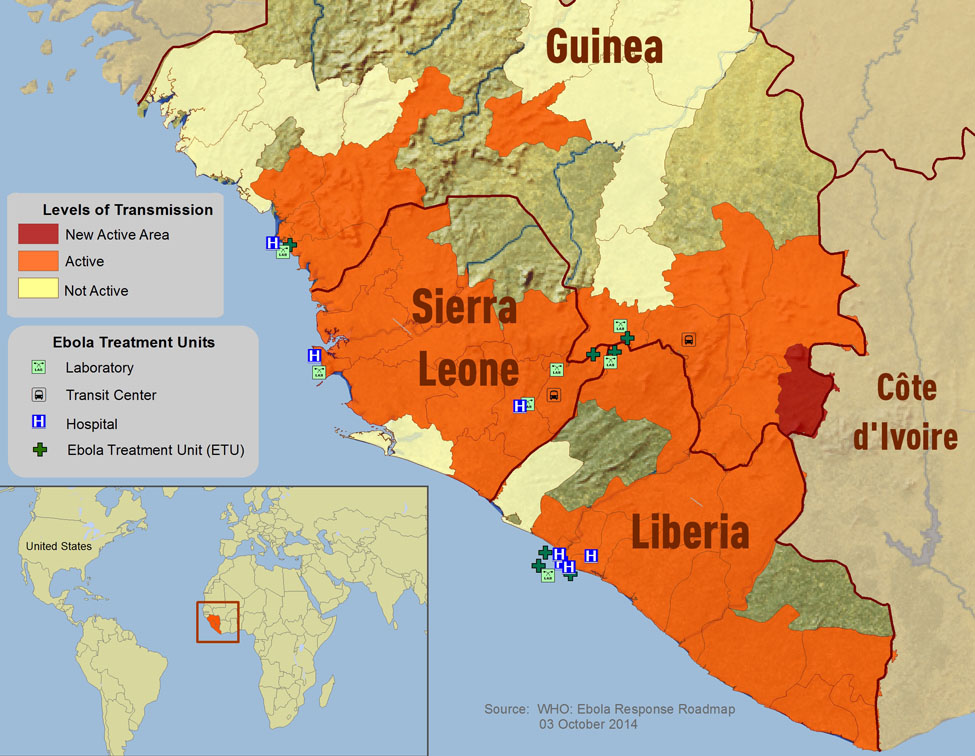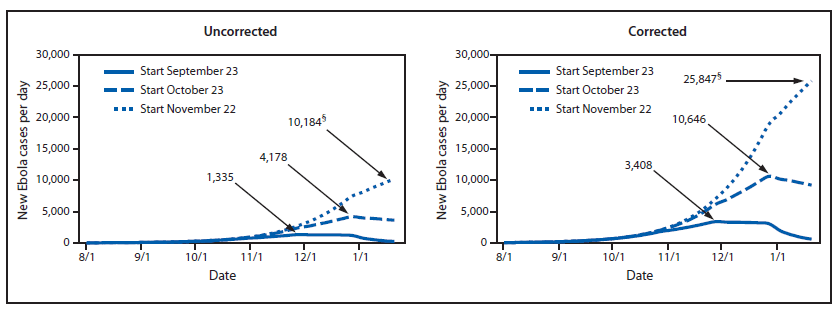
Figure 1. The Ebola virus (source CDC).
This is a good question. The current outbreak Ebola is happening in a part of the world (west Africa) where death is unfortunately all too common and where diseases like Malaria or HIV are killing many more people. Why should we care more about Ebola than HIV? Wouldn’t the resources required to stop Ebola be better spent controlling mosquitos (Malaria), or providing antiretroviral drugs to HIV patients? While I think these diseases are very important, and I wish the world did put more money into all infectious diseases, Ebola is different.
Speed
Ebola is spreading at a very rapid rate with the new case numbers doubling every 20 days or so. Diseases like Malaria and HIV are not spreading at anywhere near this rate, and while very serious, are not a threat that must be stopped today. The speed at which Ebola is spreading gives us very little time to develop control measures — we just don’t have the time to develop new drugs or vaccines (they are needed). Any delay makes the problem much, much bigger. Ebola is a problem that you can’t put off for tomorrow.
Ebola is not (yet) a human disease
This is a really important difference and one we should be most concerned about. Diseases like Malaria and HIV are human diseases, while Ebola is still a zoonotic disease caused by a virus picked up from an animal. Human diseases are adapted to infecting humans and being passed efficiently from person to person. How efficient a disease is passed from person to person is described by scientists using the term R0. This term tells you how many new people a person infected with the disease will on average infect. For example, a human disease like Polio has a R0 of between 5 and 7 (i.e. each person that gets infected with Polio will infect between 5 and 7 new people in an unvaccinated population). The R0 for Ebola in this outbreak is unknown (it ranges between under 1 to over 20 depending on the conditions), but the best estimate across the region is it is in the range of 1.3 to 1.8. This is quite low for an human disease and reflects that Ebola is not very good at being passed from person to person. This is not surprising when you remember that Ebola is a virus that normally infects flying foxes (fruit bats).
The major reason Ebola is not good at getting passed from person to person is that it kills you so quickly. Once you have symptoms you are normally dead (or hopefully on the way to recovery) within 7 to 10 days and before you have symptoms you are normally not infectious. This leaves very little time for Ebola to infect the next person, in fact Ebola is about as quick at killing humans as any disease can be and still be able to spread. If Ebola killed people any quicker (say within 3 days) then its R0 would be below 1 and the virus would have died out in humans on its own and never become a problem.
The fact that Ebola is infecting and killing thousands of people despite not being very good at it is worrying. Each person that gets infected produces hundreds of trillion of new viral particles. Many of these viral particles will have mutations (mistakes) in their genome (Ebola has a genome made up of RNA not DNA like in our own genome). Almost all of these mutated viruses are losers in the sense that the changes don’t improve Ebola’s ability to spread in humans, but just like with a lottery, the more tickets you buy the greater the chance you have of winning. By letting this outbreak run wild we are effectively buying trillions of tickets in a lottery we do not want to win — the human adapted Ebola lottery. Each person infected is making it a little more likely that a new mutant Ebola strain will arise with a much higher R0.
How would a such a mutated Ebola viral strain act? This is hard to say as we don’t know how well adapted Ebola can become to humans (we are in a way running a massive uncontrolled natural experiment to see how well adapted Ebola can become to infecting humans), but do we really want to find the answer to this question? Would it be wise to let a new strain arise that say took a month to kill you (thus allowing you to infect many more people), or one where you are infectious for a couple of weeks before the normal deadly symptoms arise? If such a strain arose then all our plans for containment of Ebola in western countries would be worthless.
We know how to stop Ebola
Unlike most human disease we actually know how to stop Ebola. All we need to do is get 70% of the infected people into simple treatment facilities where they can be cared for and where they can stop infecting new people. We have done this dozen of times with previous Ebola outbreaks and it has always worked. If we do this now we won’t have to worry about Ebola as future problem beyond being vigilant if any new zoonotic outbreaks occur. If we don’t stop this outbreak then we risk letting Ebola becoming entrenched in the human population like HIV or Polio. It is rare to have the ability to stop a new disease before it gets too big to control – let’s not let this opportunity go to waste.
Economics
One area that has received relatively little attention is the economics of Ebola. Even if the case numbers stay relatively low (say under 100,000), Ebola has the ability to cause major economic damage. As we have seen in recent weeks in the USA and other western countries, even a single imported case can cause mass concern (hysteria) leading to counterproductive proposals like travel bans and stopping flights. There is a real risk that politicians will overreact to the fears of an ill informed public and introduce policies that will disrupt international trade. The world economy is very weak; Europe is in or near to recession, China’s growth is slowing, Japan’s economy is running out of steam on the back of large VAT increases, and the resource-rich countries like Australia are slowing as commodity prices fall. With global interest rates at or near zero levels there is little that the world’s central banks can do to protect the world economy from even a small slow down in trade. With a fragile world economy we don’t want to be taking risks allowing anything that could derail growth and trade to run wild. Time to get serious.

